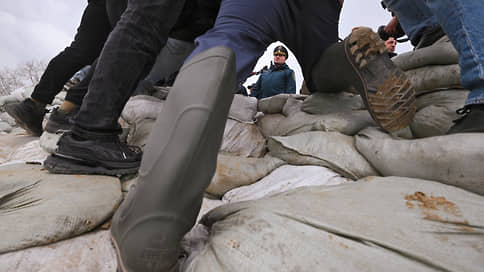In the Tyumen region, the evacuation of residents of flooded areas began
[ad_1]

Following Orsk and Kurgan, Tyumen may become the next target for floods in Russia. Regional authorities have begun evacuating residents of flooded villages on the Ishim River, where the water has exceeded the critical level of 8 m. At the same time, officials are talking about the growing likelihood of dams breaking, since “they promise a lot of water” – more than predicted. In Kurgan, the water in Tobol rose to 7.7 m, in some places in the region up to 10 m, and Telegram channels are discussing the flooding of the drainage system of the local airport, protected from water by an eleven-meter dam.
“Get valuables. Immediately go to a safe place – to your relatives or to the temporary temporary detention center” – with such an appeal the governor Tyumen region, Alexander Moor addressed after a meeting of the operational headquarters on preparation for the flood. The warning was addressed to residents of the Kazan and Ishim regions and the city of Ishim, where the water level exceeded the critical level of 8 m. Mr. Moor emphasized that the water level in the rivers will rise higher than expected at the beginning of the month. “They promise a lot of water. The likelihood of dams breaking or overflowing is growing,” the governor added. Schoolchildren in three districts were transferred to distance learning. Mr. Moore and the presidential envoy to the Ural Federal District, Vladimir Yakushev, visited the village of Kazanskoye, where sirens wailed throughout the day and residents bought five-liter bottles of water and instant noodles. “Big water will be here soon. The main thing now is the life and health of people,” said the governor.
A state of emergency in the region due to the threat of flooding was introduced on April 8. On April 11, the regional government reported that the Ministry of Emergency Situations had delivered 4 km of prefabricated dams.
Alexander Moor then predicted that 51 settlements would fall into the zone of probable flooding. A few days ago, the Ministry of Construction of the Russian Federation made it clear that the region would survive the flood with minimal damage, as it was preparing well. According to TASS, over 9 thousand residential buildings in 94 settlements may be under water. In the region, traffic on 11 bridges was limited and power was cut off in 25 settlements. Authorities expected the flood to peak on April 23–25.
IN Kurgan over the course of a day, the water rose by more than half a meter, reaching 7.7 m. The city administration reported that water from the Tobol River continued to flow into the Poplar microdistrict: “The number of flooded streets is increasing every minute.” Photos of private houses flooded up to the roofs, presumably in Poplar, appeared on local Telegram channels, accompanied by comments about “floating toilets on the property.” The authorities blocked one of the main highways of Kurgan, Tyunin Highway, and filled up the entrances to gardening communities on Gagarin Street. In total, 17 km of embankments have been erected in the city, according to officials.
According to forecasts by the Russian Ministry of Emergency Situations, 4.3 thousand houses in 62 settlements may be flooded in the region.
The head of the Ministry of Emergency Situations of the Russian Federation, Alexander Kurenkov, again arrived in the region, who flew around the flooded areas in a helicopter with Governor Vadim Shumkov and inspected the dam on the Kurgan embankment (from 500 thousand bags of soil). “This year’s floods are record high for many decades,” the minister said, simultaneously calling for “telling the truth to people.” “The best trick is honesty. If we talk to people honestly, they will believe and listen to us, which means they will clearly and clearly carry out everything that we ask of them,” believes Mr. Kurenkov. The minister assessed the preparation of Kurgan for the flood as “high-quality and fruitful.”
Earlier, the Ural Hydrometeorological Center said that the water in the vicinity of Kurgan will continue to rise, presumably passing the “dangerous” mark of 8.5 m. Meanwhile, in some areas the water level in Tobol has already exceeded 10 m. According to forecasters, the water is capable of exceeding the mark and 11 m. The Telegram channel “Air Incident” reported that the Kurgan airport is located in the protective zone of a dam 11 m high and there is no flooding on the airfield itself, “but due to the rise in groundwater levels, the drainage system of the airfield is being flooded.” However, “Air Incident” adds that water from drainage wells is pumped out by two stations with a total capacity of 350 l/s. The Kurgan airport last commented on the situation on April 11, telling TASS about regular work and preparedness for floods.
IN Orenburg In the region, the flood situation remains tense, the regional government reported. In the region, 14.4 thousand residential buildings and about 23 thousand household plots remain flooded. Officials note a “threat of overflow” on three sections of the M-5 Ural and A-305 federal highways. In Orsk, 3.2 thousand houses remain flooded, including 74 apartment buildings. In Orenburg, water flooded 5.5 thousand houses, including 55 apartment buildings.
IN Buryatia Due to the complications of the flood situation, an intermunicipal emergency regime was introduced in Ulan-Ude, as well as in the Ivolginsky and Pribaikalsky regions. According to the head of Buryatia, Alexei Tsydenov, about 600 household plots were flooded. “Work continues to blow up the ice and clean the bed of the Selenga River,” the governor said, promising residents help in drying out flooded houses using heat guns.
[ad_2]
Source link








